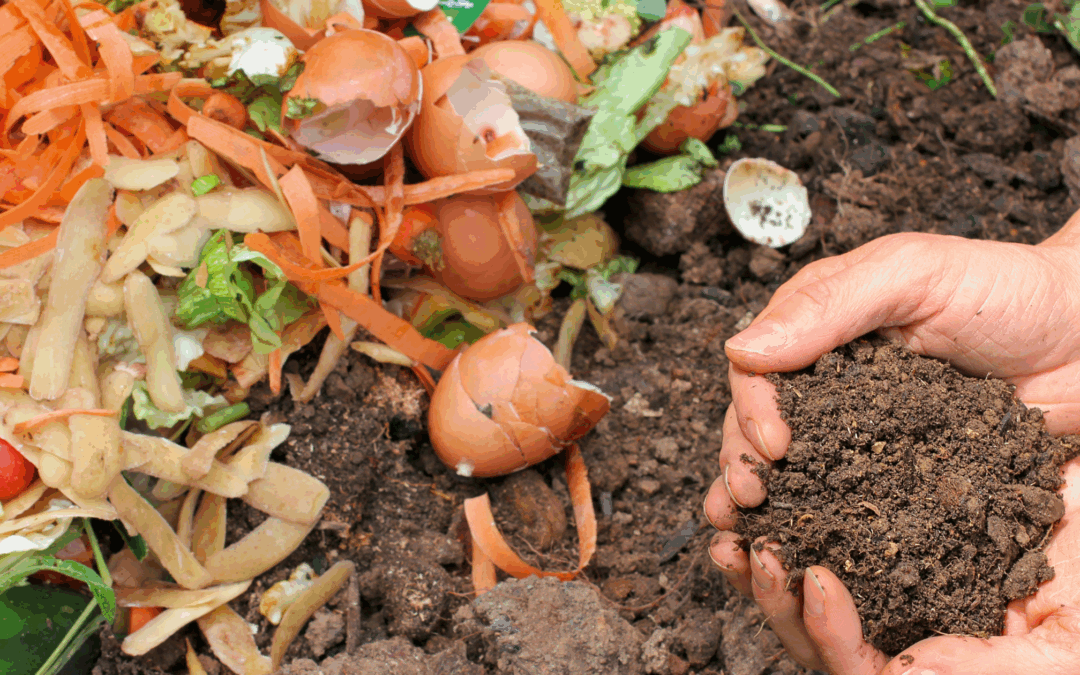
by Angela Braun | Apr 25, 2025 | Gardening
Ah compost! The gardener’s “brown gold” that is the magic bullet for all our garden problems: Wanna add nutrients to your soil? Mix it with compost. Got water retention issues? Add compost to your soil. Looking for the perfect seed-starting soil? Compost it is. In this article, I’ll show you what you need for good compost and how to make compost, even if you don’t have a garden!
Learn with this step-by-step guide how you can transform garden and kitchen waste into valuable humus.
Benefits of composting
With a compost, you can dispose of kitchen and garden waste and put it back into the natural cycle of transformation. With the help of microorganisms, all the organic material will be broken down into a new, nutritious gardening soil.
Compost improves the soil by loosening its structure and enhancing its water retention capability.
With compost, you have a natural, organic fertiliser for your plants. It’s not called “the gardener’s brown gold” for nothing. 😉
That wonderful fertiliser and soil improver will save you money.
Better still, compost is environmentally friendly as it is all natural and well tolerated by plants and soil.
Composting systems
Now that you’re ready to create your compost, you should first get an overview of the different models. They all have their advantages and disadvantages.
You must also consider how much space you’ve got in your garden, and how much garden and kitchen waste you will produce.
Open composting systems
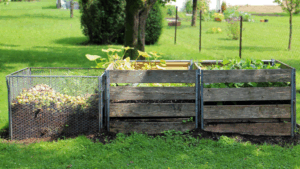
The classic open composting system is the compost heap, where you just pile all your garden and kitchen waste. Open compost heaps should be at least 1,2 m (4 feet) broad, 80 cm (2,5 feet) high and – if necessary – several metres long. They are best for large gardens with plenty of organic waste.
Open composters are usually grids or frames made of wood or metal that surround the compost heap. They are relatively cheap, and you can even build them yourself out of wooden slats, palettes or sturdy metal fences.
Open composters are well-aired and easily accessible.
On the downside, the compost in open systems needs more time to mature, up to 12 months and longer.
Closed composting systems
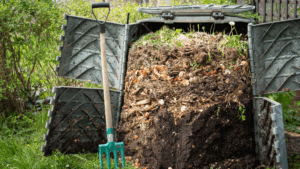
Closed composters are usually made of well-isolating plastic or metal containers that usually come with a flap on ground level where you can take out the mature compost. They should be able to contain at least 200 litres to make sure that the composting process takes place fast and effectively.
They protect against weathering and animals (like rats) and require less space than open systems.
Their most important advantage is that they generate high temperatures, making the compost mature a good deal faster than in open systems. These systems are often called thermo composters.
Disadvantageously, closed composters are more expensive than open ones
An alternative closed composter that needs less space is a drum composter. By regularly turning the drum, you’ll mix the waste and provide it with oxygen.
If you want to buy a thermo composter, make sure that the plastic is weather and UV resistant.
Composters for the balcony
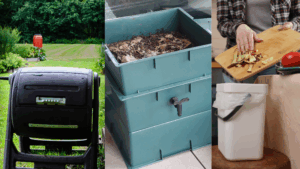
Even on a balcony or patio, you can make compost.
You can, for example, use the above-mentioned drum composters that have a compact size.
Also, worm bins are a good method of composting with little space. They do not smell and are very efficient. You can either buy worm bins or build them yourself. The necessary composting worms can be bought online.
Another great method of composting with limited space is a Bokashi bucket, in which you ferment your organic waste and transform it into nutritious soil.
How to make compost: finding the right location
A compost, no matter which system you choose, is usually not a very pretty sight. Sometimes, it can even smell bad. So, to avoid stress with the neighbours, you shouldn’t place the compost directly at the property boundary.
The perfect location for your compost heap should lie in the half-shadow, maybe under trees or (fruit) shrubs. That way, it’s not only protected from winds and sun but also from views. If you have the possibility to hide it, do so.
It’s also important that you can access your compost with a wheelbarrow. All that black gold has to be transported to your patches 😊
Compost should not lie in the direct sun as it dries out very fast. Yet, I don’t have (half-)shade in my garden, and so the compost is exposed to the blazing sun. To keep it from drying out, therefore, I have to water it during the summer, and sometimes I put a cardboard on top to keep the moisture in.
Composts should always have direct contact with the soil. That way, worms and microorganisms can get into it, and excess water can flow away. Even many closed composting systems are open at the bottom. With a floor grid, you can prevent voles, rats, mice and other pests from entering.
If you want to compost on the balcony, make sure that the total weight doesn’t exceed maximum load.
Basic composting factors to observe
Before you make a compost, there are some basic factors you have to observe:
Size
Closed systems have a preset size but an open system should be at least 1 x 1 metre (3,5 x 3,5 feet) to produce enough heat for the rotting process. Larger compost heaps should not be broader than 2 m (6 feet) to ensure sufficient ventilation.
Material
The one thing we need to make compost is: compostable matter! Usually, we get plenty of organic waste from our garden and the kitchen.
“Brown” material like wood chips, twigs and branches, straw and leaves contains much carbon (C)
“Green” material like grass clippings, kitchen waste, weeds, coffee grounds, or manure contains more nitrogen (N).
For an optimal composting process, the ratio between carbon and nitrogen should be between 15:1 and 25:1. That means that we compost more brown material than green one. Ideally, we collect brown material and every time we throw some green material on the compost, we add an amount of brown material.
Chop up large chunks of wood or vegetables to accelerate composting, but don’t make them too small. Sizable parts of organic matter make sure that air is held within the heap, which prevents it from moulding or putrefying.
Oxygen
Oxygen is a vital factor for the composting process. Make sure your heap is well-ventilated by adding coarse material like twigs, straw and leaves.
Moisture
Your compost should be moist but not wet. If it’s too dry, water it now and then; if there’s heavy rain, cover it to avoid putrefaction.
The best time to start a compost
Basically, you can start a compost at any time of the year, but I recommend the warm seasons. Life in the compost heap, like bacteria, microorganisms, worms and other creatures, develops and thrives better when it’s warm.
In winter, however, there is next to no activity. The beneficial bacteria are slow and me even stop working when it gets too cold. It may help to cover the compost to protect it from cold and wetness.
How to Make Compost in 8 Easy Steps
Step 1
Lay a grid against voles and mice on the ground. Then, build a basic layer of coarse material like twigs, straw or leaves. This layer ensures good ventilation and prevents waterlogging.
Step 2
After that, alternately layer green materials (moist and nitrogen-rich) like grass clippings, vegetable scraps or coffee grounds and brown materials (dry and carbon-rich) like leaves, straw or chopped loppings. Each layer should be about 10 – 15 cm (4 – 6 inches) high. The smaller the materials, the faster they decompose.
Step 3
Activate your compost by one of the following methods:
- Add mature compost as a starter. It contains the microorganisms required for composting.
- Mix a compost starter from 10 litres of lukewarm water, 1 kg of sugar and two packages of dry yeast and pour it over the compost heap. The microorganisms love that!
- Have you ever heard of Effective Microorganisms? They are mixtures of different aerobic and anaerobic microorganisms that can, among other uses, accelerate composting.
Step 4
If necessary, water the compost to ensure enough moisture. Compost should always be moist but never wet.
Step 5
Cover the compost heap on hot days with a layer of leaves, straw or cardboard to prevent it from drying out and overheating.
Step 6
Oxygen is an important factor for composting. Mix in enough coarse material to get in air pockets and (optionally) turn the compost over every 4 – 6 weeks to mix the ingredients well and ventilate it.
Step 7
Let the compost mature for about 6 – 12 months. During that time, microorganisms and soil organisms break the material down and transform it into nutrient-rich humus. You know that your compost is ready when it looks dark and crumbly and smells of forest soil.
Step 8
When your compost is ripe, you can use it as a fertiliser and soil improver in your garden. Distribute the compost on your patches to provide your plants with nutrients and loosen up the garden soil. You can also use mature compost as potting soil for balcony boxes and planting pots.
What to put in the compost
The following materials are good for composting:
- Garden waste: leaves, straw, hay, grass clippings (dried), loppings, weeds (without seeds), plant remains
- Kitchen waste: fruit and vegetable remains (untreated), coffee grounds
- Egg shells (crushed)
- Tea and coffee filters (from paper)
- Sawdust and wood shavings (untreated); don’t use too much of it as it may attract wireworms
- Litter from small animals (plant-based and untreated), manure, feathers
- Paper and cardboard (uncoated and in small amounts)
What NOT to put in the compost
Do not put any of the following on your compost:
- Cooked or baked food
- Meat and fish remains
- Dairy products
- Weeds with seeds or roots that hardly decompose (e.g. goutweed, couch grass). Plants with contagious diseases like blight or mildew. The disease is not killed but spreads through the new compost into the soil and infects your whole garden. Always throw parts of ill plants into the garbage bin.
- Treated wood, plastics or metals
How to use compost
There are different stages of decomposition and in each of them the compost can be used, but for different purposes.
Half-rotted compost: Mulch
The temperature of the compost heap has decreased, and large chunks remain. You can now use them as mulch for your patches.
Nearly mature compost
The temperature has fallen to normal, and there are only a few smaller bits and pieces in there. The compost smells of forest soil. Now you can use it as fertiliser for heavy feeders like cabbage, tomatoes and cucumbers.
Mature compost
The compost has a dark colour, a fine and crumbly structure, and it smells of forest soil. Use this compost as seed-starting soil or make a new vegetable patch with it.
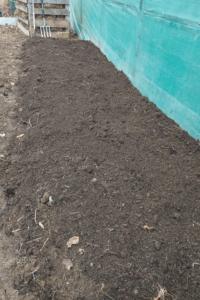
I made a new patch with my compost where I’m going to plant strawberries
You can throw the compost through a sieve and sort the chunks out. They need a bit longer to decompose so put them back in the compost.
Usually, compost is distributed in early spring, as soon as the soil warms up and needs new nutrients for the plants. Add a layer of about 2 cm (1 inch) of compost to your vegetable patches, flower beds or under your fruit trees and bushes and rake it slightly in.
You can add compost to your soil in autumn as well, but only as long as the soil is still warm. And you need to cover it with mulch afterwards.
If you can’t use the compost right away, store it in closed buckets until you need it. That way, the nutrients won’t be washed out by rain.
Compost maintenance
Once you’ve layered all the material, your compost doesn’t need you to do its work. However, there are a few factors that need controlling to ensure a fast and good decomposition process:
Temperature
In closed composting system the temperature will get higher than in open systems. The hotter the temperature, the faster the composting process will be.
Moisture
If the compost is too dry, the microorganisms can die; if it’s too wet, it may rot. But how to know if the moisture is right? I usually take a large stick and poke some holes into the compost. When it feels like a squeezed sponge, the moisture is right.
Oxygen
Composting needs oxygen to work properly. That’s why it’s so important to not add too many (wet) grass clippings to your compost as that would lead to an anaerobic (that is: without oxygen) mass that moulds and rots.
Compost troubleshooting
Composting does not always go without trouble. Here are the most common problems and their solutions.
#1 The compost stinks
The reason for bad smells from the compost is that it has too little oxygen and thus creates an anaerobic atmosphere.
Solution:
Check if your composting system is water permeable towards the ground and the cover is water-tight.
Open the composter and shovel everything out. Now put it back into the composter, but mix in plenty of dry brown material to keep oxygen in.
#2 The compost moulds
Although we associate mould and mildew with moisture, it’s the contrary: the compost is too dry.
Solution:
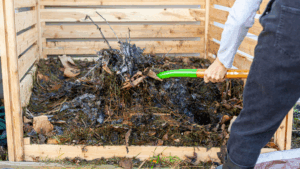
Turn the compost over and mix in some mature compost to reactivate it. Then water it with several buckets of water and keep an eye on its moisture the next time.
#3 Animal infestation
Animals like rats, voles or mice can be attracted by a compost heap.
Solution
Make sure that it’s well protected, for example by putting a metal grid on the ground before starting the compost. Also, don’t ever put meat, fish or cooked food on the compost!
#4 Composting takes too long
Although composting takes its time, more than a year is too long. This may be caused by too little moisture or an imbalance in green and brown material.
Solution:
Turn the compost and add what’s necessary, either moist or dry material and mix it regularly. That way, oxygen gets in, and the good microorganisms thrive.
Composting is not difficult. With the right tips and tricks you can soon transform your garden and kitchen waste into great humus for your garden. Just make sure to use the right materials, to layer the compost in the right way and to give it enough oxygen, moisture and warmth. That way, you contribute to a sustainable eco-cylce and do something good for your garden. Your vegetables will soon thrive in the “brown gold” and reward you with a great harvest. So, get out there, look for a good spot and start composting!
Cant’t get enough of garden topics?
Read on here:
How to plant, grow and harvest tomatoes in 14 steps
Small garden, huge harvest: Maximising your small vegetable garden
Seed-starting cucumbers: how to get healthy seedlings
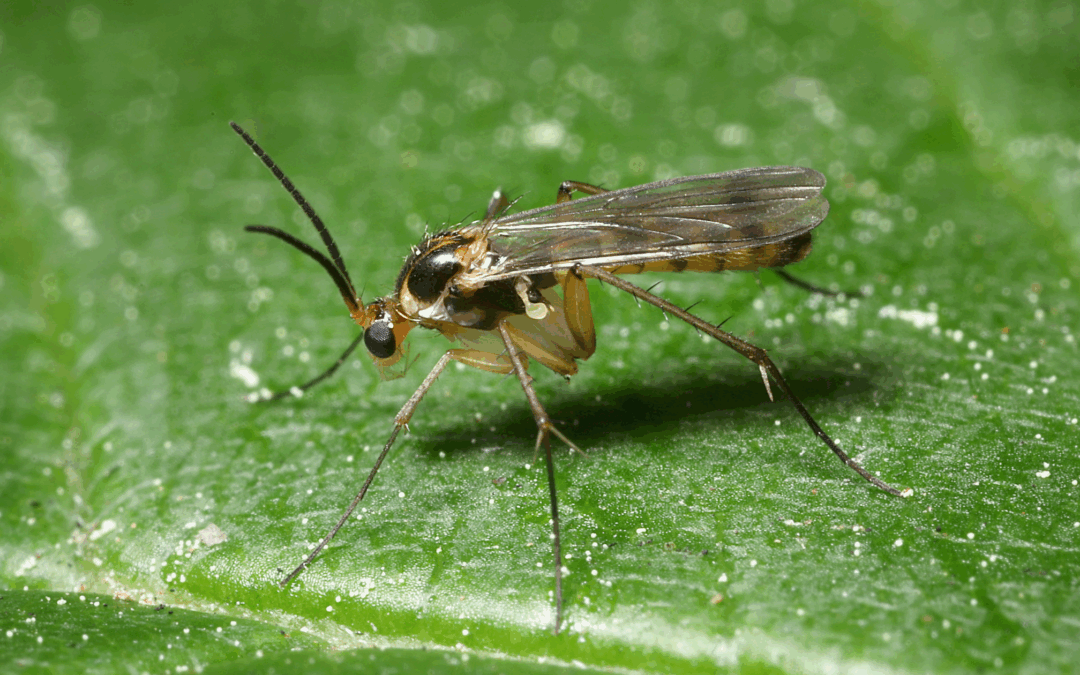
by Angela Braun | Apr 17, 2025 | Gardening
Nearly everybody who has indoor plants will sooner or later make the dubious acquaintance of fungus gnats. Not only but especially in winter, those tiny black insects whirl up from the soil when we water our plants and fly around seemingly aimlessly. Unfortunately, fungus gnats are not only an annoying or aesthetic problem but a real threat to our seedlings because they like to nibble on plant roots! If we only had two or three gnats taking a small bite out of the roots, that wouldn’t be a problem. However, as it happens, fungus gnats never work alone but rather in clouds of gazillions. You can imagine the havoc these numbers can wreak among our baby vegetables. In order to find out how to get rid of fungus gnats, we first must look at what they are exactly.
What are fungus gnats?
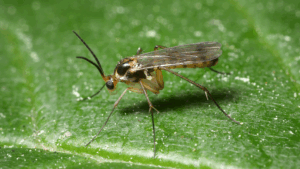
Fungus gnats can be found all over the world. In Europe, there are around 600 different types. They are related to midges but cannot sting. In nature, especially in woods or moors, but also in gardens, their larvae play an important role as they decompose organic material.
Fungus gnats are often introduced with potting soil that already contains eggs or larvae, but they can also get into the house through open windows.
You have an infestation when swarms of 2 – 4 mm small black insects rise from the pots every time you move or water them. Contrary to fruit flies, fungus gnats have long legs and feelers as well as large wings. They preferably lay their eggs in the moist soil of indoor plants, and one female can lay up to 200 eggs, out of which wormlike, about 5 – 7 mm long white larvae hatch. They live in large groups in the moist soil. After about 13 days, the larvae pupate, and five to six days later, the fungus gnats hatch.
What damages do fungus gnats cause?
While the black fungus gnats are only pesky, their larvae, which live in the soil, eat not only dead plant parts but also the plants’ roots. Large plants can usually cope with that, but seedlings and cuttings can die. The damaged roots can’t take up enough water and nutrients, and bacterial and fungal diseases can penetrate into the plant through the open roots.
How to get rid of fungus gnats
Now, the good news is that there are ways to get rid of those little black beasts – and without throwing a chemical bomb into your living room. Read on!
Prevention
Prevention, they say, is better than cure. So the best way to get rid of fungus gnats is to not let them in in the first place.
Soil preparation
Since we mostly bring fungus gnats in ourselves with the soil we use for potting or seed starting, it’s certainly a great idea to give that a closer look. Only buy high-quality potting soil in undamaged sacks. If you use your own potting preparation, for example with compost, sterilise it before use. For that purpose, heat the soil in the oven at 150 °C (300 °F) for 30 minutes and let it cool down.
Watering correctly
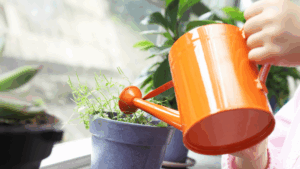
As fungus gnats need moist soil to survive, we should only water our plants when the surface is really dry. However, this can be a bit tricky with seedlings as they must not dry out. It’s better to water several times a week with little water instead of once with a lot. Reliable water monitoring is essential when it comes to healthy seedlings and getting rid of fungus gnats.
Traps
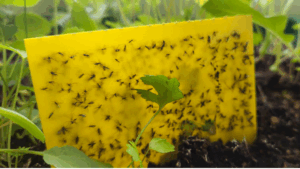
There are those yellow sticky traps that you can put into the planting pots. They attract (amongst others) fungus gnats, which will stick to the gluey cards. However, those traps only catch the male gnats, and although males and females are necessary for producing fertilised eggs, sticky traps are not enough to get rid of all the gnats in your home. The traps are an indicator of an infestation and also a good addition to the next steps:
Natural antagonists
Nematodes
There is a kind of secret weapon, like a SWAT team, in the battle against fungus gnats: nematodes (Steinernema feltiae or SF-nematodes). They are minuscule, wormlike animals that live in the soil and kill fungus gnats’ larvae. Sounds disgusting, but it works wonderfully and is a great non-chemical way of getting rid of our plants’ unwanted roommates.
You can buy nematodes online. They come in small packages and look like a powder that you have to dilute with water. I always use a large mason jar for that, and then add the dilution to the watering can, where I fill it up with more water.
Before you spread the nematodes, however, the potting soil must already be moist. Nematodes (like fungus gnats) die in dry soil, so water your plants in advance, then bring out the nematodes and keep the soil moist during the next weeks. It usually takes about 2 – 4 weeks to notice a considerable decline in fungus gnats.
Predatory mites
Like nematodes, predatory mites also find fungus gnats irresistible. You can use the types Hypoaspis miles, Hypoaspis aculeifer Macrocheles robustulus. They usually come as a granulate that you spread on top of the soil.
Bacteria
Special bacteria, like Bacillus thuringiensis subsp. Israelensis are also a good weapon against fungus gnats. Like nematodes, they are diluted in water and poured on the potting soil with a watering can.
Neem oil
Neem oil affects insects’ hormonal system and prevents them from forming chitin, so that they will not reach the stage of mature gnats and, as a consequence, are not able to reproduce. If you are sure that there are no beneficial insects in the vicinity that you want to spare, neem oil is a good way to get rid of fungus gnats. I wouldn’t use it outside, though, for fear of affecting bees and other pollinators.
Soil cover
A well-known home remedy to prevent the gnats from laying their eggs in the soil is to cover it with quartz sand, where the flies will not get through it. However, the layer should be about 1 cm (0.5 inches) thick. Sprinkle a bit of baking soda on top of the sand to set a double barrier.
Tempting as it might be, however, do not cover your potting soil with organic material as that provides nourishment for the gants and larvae.
However tedious, fungus gnats are not one of the seven plagues, and as easily as we can bring them in unconsciously, we can get rid of them. It’s best, of course, to take precautions, but as you have seen above, there are also several non-chemical ways to protect our green friends from those root nibblers.
More garden talk? Read on here:
Seed-starting cucumbers: how to get healthy seedlings
23 Common Vegetable Gardening Mistakes (And How to Fix Them!)
Succession Planting Guide: Maximize Your Vegetable Garden Harvest Year-Round
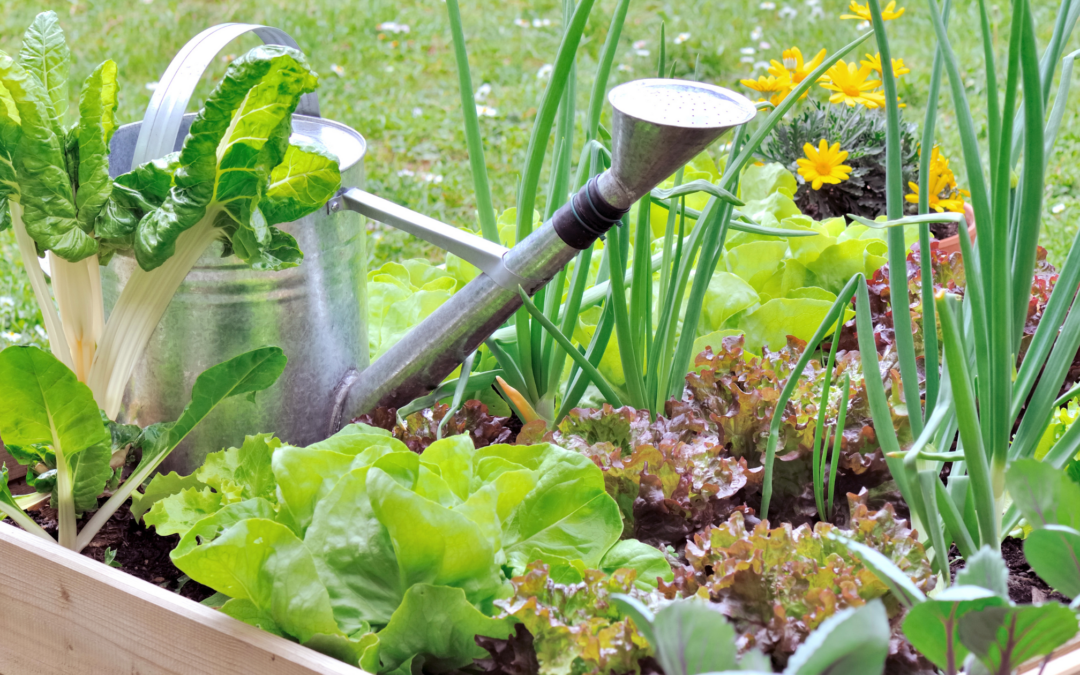
by Angela Braun | Apr 11, 2025 | Gardening
When I was a child, we had a vegetable garden of about 40 square meters. Seeing that we were six people and Granny also had a patch for her and Gramps, it was a relatively small garden. Yet, it produced most of our vegetables, and we rarely had to buy any from the supermarket.
Today, my mom is still an avid gardener, but she cultivates only two raised beds for her and my dad, which is plenty of work for an octogenarian. Surprisingly enough, like before, those beds (and a few pots) provide them with most of their veggies throughout the growing season. That shows that a small space is no excuse for not starting a vegetable garden! Let me show you how you can also have a huge harvest in your small space vegetable garden.
Small vegetable gardens: Choose your site
If you have already established patches or raised beds to grow vegetables, that’s fine. But if you’re just starting, there are a few things to observe.
Location
Vegetables need light to grow. It doesn’t matter if you have a small garden with a tiny bed or just some pots on a patio, as long as your veggies get enough sunshine, they’ll be fine.
Inventory
Take inventory of what plants already grow in your garden and use the different growing heights to your advantage. If you have some shrubs and bushes, for example, you could plant herbs which grow smaller, on the south of them and proceed with vegetables. That way, you can cultivate fruits, herbs and vegetables in a comparatively small space.
Patches and Co.
If you have the opportunity you can create some garden patches with this easy method (no need to dig, I promise!). But even if a coherent gardening space isn’t possible, maybe you can create “pockets” within your garden, which means single patches scattered throughout your soon-to-be small vegetable garden.
Raised beds may be a good idea, no matter if you have a garden, patio or just a balcony.
Last but not least, pots and containers fit on the tiniest balcony. You’ll be surprised to see what you can grow in pots!
Dreaming your small vegetable garden
Every garden, even a small one, needs a plan! I know it can be tedious to create one, but I promise you it’s worth it.
Choosing vegetables
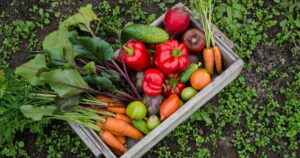
To make a plan, however, you must decide first what vegetables you want to grow. Make a list with all the veggies you like AND which don’t require too much space.
Good, and beginner-friendly, examples are Swiss chard, Chinese cabbage, peas, beans, leeks, carrots, garlic, onions, kohlrabi, radishes, turnips, beetroot, stalk celery, lettuce and lamb’s lettuce.
For a small vegetable garden, it’s also clever to choose vegetables that grow vertically rather than horizontally. Runner beans, for example, that grow upwards on trellises, may be a better option than bush beans, which require much more space.
If you have one or two vegetables that you absolutely want to have, although they normally need too much space, include them in your plan. Growing our own food should be fun, and not a way to limit ourselves. Growing them in pots is usually a great option.
Look for high-yielding vegetables that produce a huge harvest. Good examples are zucchini, carrots, onions and tomatoes.
Make sure you cultivate varieties that are robust and well-adapted to your climate and hardiness zone, and prefer heirloom and resistant varieties.
Choose vegetables that are easy to cultivate like lettuce, Swiss chard, garlic and beetroots.
It’s also good to have vegetables that grow fast, like radishes, beets, Swiss chard and spinach and veggies you can harvest for a long time, like lettuce, runner beans, leek, stalk celery and kale.
Small vegetable garden: Make a cultivation plan
Now that you have your list of vegetables, it’s time to make a plan. If you have patches or raised beds, draw them on paper and outline which plants you want to grow where. To make the best of your space, combine high and low-growing plants.
The right combinations
Randomly mixing vegetables can work, but usually, it won’t. It’s good, therefore, to know which plants to grow together and how to combine different veggies.
Companion planting
Also, bear in mind which plants like each other (and which don’t). Like with humans, plants have special friends whom they grow great together with and others they can’t stand. You’ll find a list of vegetables and their best buddies in this article about companion planting.
Crop rotation
Even in small vegetable gardens, you should observe the principles of crop rotation, which divides vegetables either by family, category or nutrient uptake and rotates them every year. That way, the soil stays healthy and pests and diseases can’t spread easily. For a comprehensive outline on crop rotation, including exemplary rotation plans, hop over here.
Succession planting
Whenever we harvest a plant (or plants), we should immediately sow or plant afterwards. That not only makes sure that the soil is always covered but we can also harvest continually throughout the season. Find examples for succession planting in the vegetable garden in this article.
Soil preparation
Now that we have a plan, we prepare our patches. No matter the kind of patches or pots we have to grow our vegetables in, soil preparation is essential for a good harvest. And what would be better than
Compost
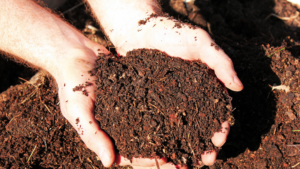
Compost is a universal remedy. It improves the soil structure, stores water, provides nourishment for the soil organisms and nutrients for the plants.
A generous layer of compost on the soil is a great method to ensure a huge harvest.
“Homemade” compost is certainly best, but if you don’t have enough “homemade” compost, I recommend buying some from a composting plant. It’s usually of better quality than the stuff in plastic bags you can buy in the supermarket, and it’s cheaper.
Manure
If you have livestock and use their manure for the garden, the soil will become increasingly fertile with time. Chicken manure, for example, is a marvelous fertiliser.
Horse manure has less nutrients than other manure, but the nutrient content is very balanced. Yet, no matter what animals you have: your garden will profit from their manure in any case.
Even if you don’t have any livestock, you can ask on farms, horse stables, or other animal owners if you can have some manure for your garden.
The only thing you have to keep in mind is that fresh manure is usually too „hot“ for most plants, and they would burn. For that reason, you must compost it before you can use it in your garden.
Cultivating your small vegetable garden
Made a plan: check
Prepared the soil: check
Now we can plant!
Intensive cultivation
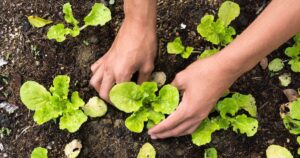
When you use compost to enhance your soil’s fertility, you can plant your vegetables more closely than indicated on the seed packages. Especially leafy vegetables can be planted closer together and a smaller planting distance means a higher yield.
Another example is head cabbage, which needs a lot of space as it grows relatively expansive, and we should plant it with the right spacing.
Normally.
We can intensify the space yield, however, when we plant leeks between the cabbage rows. The cabbage grows on the ground and leeks at the “first floor” without them getting in each other’s way.
Pots and containers
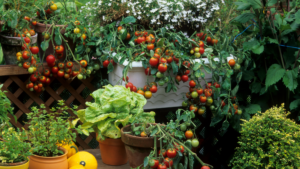
For most gardeners, tomatoes and cucumbers are a must-have. Unfortunately, they require a comparatively large space to grow healthily and bring a good harvest. Instead of growing them in our patches or raised beds, therefore, we plant them in pots and containers. Just make sure that the pots are large enough and that you put them in a protected, sunny spot.
Attract pollinators in small vegetable gardens
Fruiting vegetables like tomatoes and cucumbers, but peas and beans, as well, need insects to pollinate them. To attract these pollinators, it’s a good idea to plant blooming herbs or (edible) flowers like calendula or nasturtium between our veggies or around the patches. Bees and other pollinating insects will love them, and as a thank you, pollinate your veggies.
Harvest
Many gardeners hesitate when it comes to harvesting, but harvesting is our goal, isn’t it?!
When you cultivate vegetables that can be harvested for a long time, like lettuce, runner beans, leek, stalk celery and kale, make sure to harvest them continually throughout the season. That way, you drive them to grow more leaves or fruits.
As soon as you have harvested any veggies completely, sow or plant immediately afterwards so that the next batch of veggies is on its way.
Having fewer vegetables makes us want to use more parts of them. Did you know, for example, that you can mix the leaves of beetroots, carrots and Florence fennel with your lettuce? Or that the leaves of radishes make a wonderful pesto? You can also cut off garlic greens and put them in your salad or cook with them. They have a mild garlic taste and improve every dish.
Lastly, why not harvest edible wild plants that grow in your garden? One of the most dreaded weeds, goutweed, for example, can be perfectly baked into pancakes or used up for a wild herb pesto.
The leaves of stinging nettle can be mixed with spinach or cooked into a soup.
Dandelion flowers can be cooked into a thick syrup, the dandelion honey, while the young leaves in a spring salad are great for the liver.
Not enough garden talk yet?
These articles may also interest you:
Beginner’s guide: How to start a vegetable garden
Natural fertilisers from animals
Easy Vegetables for Beginners: 11 Foolproof Crops for Your First Garden in 2025
How and when to plant garlic
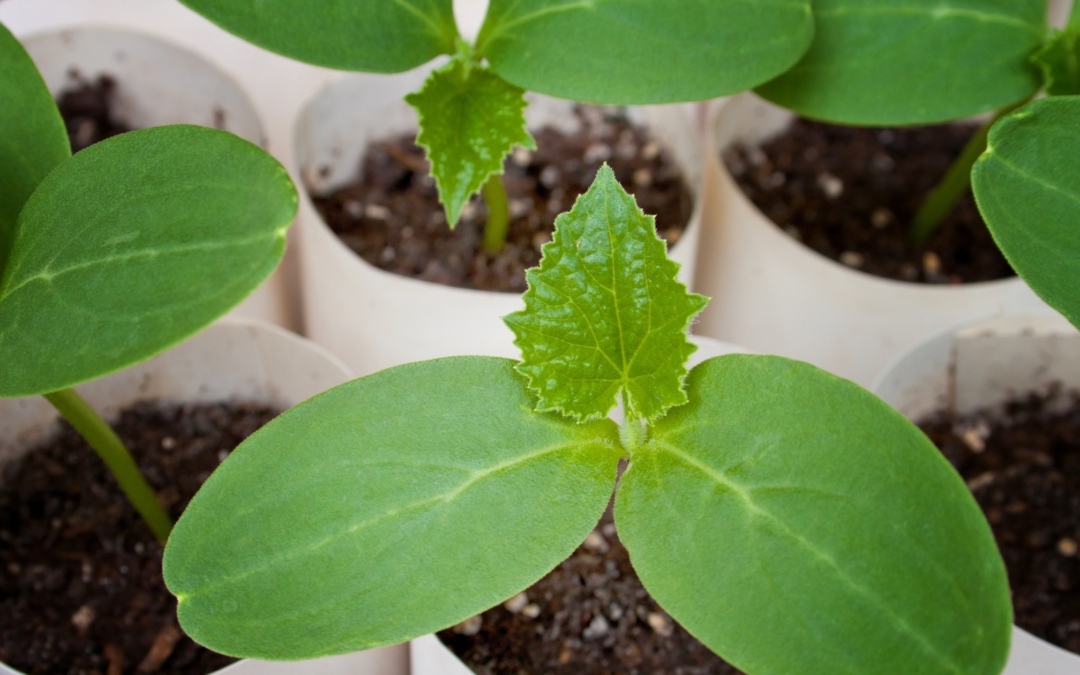
by Angela Braun | Apr 8, 2025 | Gardening
Vegetable garden, greenhouse, balcony, or patio: Cucumbers thrive in many environments and brighten your summer with fresh, crisp fruits. They are a vegetable that can be easily seed-started indoors. Let’s have a look at how it works.
Cucumber varieties
Depending on where they grow, there are different varieties of cucumbers. Snack and pickling cucumbers grow well outdoors and even in pots, while snake cucumbers prefer to be cultivated in a greenhouse.
Seed-starting cucumbers for greenhouse cultivation
Many cucumbers for the greenhouse produce only female flowers, which makes them more productive.
Cucumber varieties with only female flowers are also called “parthenocarpous”. That means that they don’t need male pollen for fertilisation and don’t produce seeds.
If you choose a parthenocarpous cucumber variety, make sure that you don’t plant other varieties with male flowers in the vicinity. Otherwise, bees could bring in male pollen – and you‘ll get a smaller harvest.
Seed-starting cucumbers for outdoor cultivation
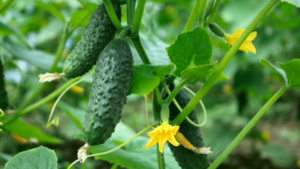
Outdoor cucumber varieties are often smaller and have less smooth skin, but they often taste more aromatic and stay fresher and crispier.
If you want to cultivate your cucumbers in an unprotected place, I recommend the robust outdoor varieties. They are not as prone to mildew as the more sensitive greenhouse cucumbers.
But cucumbers are not only for fresh consumption. There are several varieties, especially for preserving. My favourite variety for pickles and ferments is „Boston Pickling“. Its fruits stay smaller, and they grow well outdoors.
The right time
At the beginning of April, you can seed-start cucumbers indoors. I also recommend sowing cucumbers in several batches between April and mid-June. This succession planting will make sure that you can harvest cucumbers throughout the whole season.
Seeing that sometimes older plants get infected with (real or false) mildew, a further batch provides you with fresh fruits.
Seed-starting cucumbers: 8 steps for healthy seedlings
To make sure seed-starting will be a success, let’s go from sowing to transplanting step by step!
#1 How many do I need?
If you want to be self-sufficient with cucumbers, I recommend cultivating two to three plants per household member. For pickling and fermenting you can even calculate some more. That way, you can preserve cucumbers for the winter months.
#2 Equipment
Fortunately, there’s not much equipment you’ll need:
- pots of about 10 x 10 cm (4 x 4 inches)
- matured compost or cultivation soil
- cucumber seeds
- a small watering can or a ball shower
Did you ask yourself if you could sow in compost? Yep, that’s possible, BUT only in mature compost. If it looks dark and smells like a forest, it’s ready for seed-starting.
#3 How to sow cucumbers
Take your pots, fill them with mature compost or cultivation soil and make a hole of about 2 cm in it. There, you put in two seeds. Unfortunately, there’s always the risk that some seeds won’t germinate. By putting two seeds into the pots, we minimize that risk. If both germinate, rip out the weaker plant (even if it’s hard for you).
Now cover the seeds with soil, press it slightly and water the pots with the watering can or ball shower.
#4 Do NOT thin out cucumbers
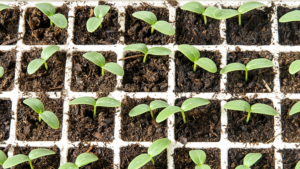
Cucumbers don’t like it when their roots get messed with. For that reason, we seed-start them in pots that are large enough for them to grow until they’re transplanted outdoors or into the greenhouse without being uprooted.
#5 Temperature and light
Cucumbers like it hot, about 25 °C (77 °F), for germination. I usually place the pots above the radiator, or I use a heating mat to create a cosily warm atmosphere for my cucumber babies.
When the have germinated and look out oft he soil, they need less temperature but more light. At that stage, I move them to the guest toilet where it’s a few degrees colder (18 – 20 °C / 64 – 68 °F). Now they need more light to grow, about 12 – 16 hours per day and at best special wavelengths.
It’s difficult to get that amount of light at the beginning of April which is why I have several plant lamps installed. The right light is essential for a sturdy growth. If there’s too little, the plants will get leggy and weak.
Want more tips about successful seed-starting of vegetables? Here is a comprehensive article on seed starting for beginners.
#6 Fertilisation
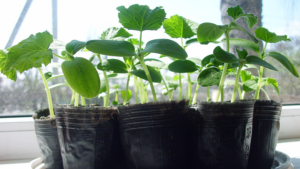
When your cucumbers are 2 – 3 weeks old, they need their first dose of fertiliser. It’s best to use a liquid fertiliser that you dilute with water (I usually use half the amount indicated on the package) and water your plants with it.
At that stage, cucumbers need a small dose of nitrogen to get them going and induce a helathy growth.
#7 Watering
You shouldn‘t water any seedlings from above but rather into the saucer or holder. That way, the water can absorb up into the pot and the seedlings can take how much they need. It’s the simplest and best way to water seedlings, and you can even fertilise them that way.
But be careful: don’t over-water your seedlings! A short period with a slightly drier soil helps them to develop strong roots.
#8 Hardening off
Before planting your cucumbers outdoors (here that’s around the mid of May), you must harden them off to get them used to the harsher atmosphere outside. About a week before the „great day“, start to put them outside at a protected and shady place for 2 – 3 hours. Prolong that time over the next days and also put them into the sun. After about 7 days, they are hardened off enough to get transplanted outdoors.
Now you can also sow cucumbers directly into the patch.
Have fun seed-starting your cucumbers! If you want to read on, here are some articles you may also like:
How to plant, grow and harvest tomatoes in 14 steps
10 Surefire Companion Planting Pairs for First-Time Gardeners
What to Sow and Plant in April: Kickstarting Your Vegetable Garden

by Angela Braun | Apr 3, 2025 | Gardening
As spring fully takes hold, April is a pivotal month in the gardening calendar. The soil is warming, daylight hours are increasing, and plants are awakening with renewed vigor. This month presents the perfect opportunity to set your garden up for success throughout the growing season. Let’s see what garden tasks wait for us in April:
#1 Weeding
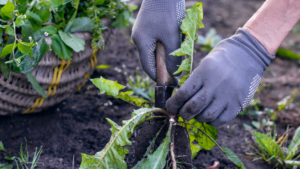
Earlier in March, we pulled the mulch off the patches so that the sun could warm the soil. With rising temperatures, however, weeds will also find their way towards the light. Now, when they’re still small, is the right time to pull them out and keep the patches free for our vegetables.
#2 Harden off seedlings

Some of the vegetables we have seed-started indoors during the last weeks can be planted outdoors in April. Before we do that, we must harden them off so that they won’t get a shock when they get from that cozy, protected atmosphere indoors to the outside garden where temperatures are colder and the wind can blow harshly.
To harden off our seedlings, we put them outside in the shade. At first, for a few hours and each day longer. After about a week, they can be planted outside.
If you want to know which vegetables you can plant outdoors now, read on here.
#3 Sowing and planting outdoors
The greatest garden task in April is sowing and planting! So many vegetables can now be sown and planted outdoors, cabbage, leeks, radishes and peas being only some of them. For a comprehensive list of vegetables you can sow and plant outdoors in April, read on here.
#4 Fertilising
Our vegetables have outgrown the baby and toddler stage and are now teenagers. Ravenous teenagers! Which means they need plenty of food, or in that case, fertiliser. After planting our seedlings outdoors, they’ll be grateful for a healthy dose of organic liquid fertiliser to push their growth.
#5 Protect seedlings from cold
Sowing and planting outdoors brings so much fun, but remember that it can still get cold, especially during the nights. In my hardiness zone 7b, the danger of frosts won’t be over before mid-May! To protect our sensitive seeds and baby vegetables from harsh weather, we must cover them with a fleece. Although that won’t seem much, it will be enough to keep the air and soil underneath well above freezing.
#6 Protect cabbage and leeks from pests
Cabbage and leeks that we can plant outdoors now are especially prone to pests like the cabbage white butterfly and the leek fly. To protect them, we can cover them with a protective net, which is much lighter than a fleece. It won’t keep off the cold but only the pests. Most often, you can buy protective nets as a set with half-arches that you can stick across the vegetables and put the net on top. That way, our plants have plenty of room to grow while being safe from pests. Just make sure that you fix the net thoroughly into the ground.
By the way, celery is a good companion for cabbage. In the unlikely event that a cabbage fly finds its way under the net, it may find itself repelled by the celery smell.
#7 Protect your seedlings from snails and slugs
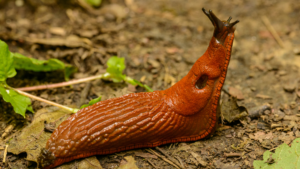
Is there any pest more feared than snails and slugs? I don’t think so. They are practically everywhere and, especially in spring, eat all they can find. Our seedlings are kind of a huge buffet to them, and if we want to harvest some vegetables for ourselves, we must make sure that snails and slugs won’t get near them!
A good way to keep those little suckers off our seedlings is to put snail collars around them which they can’t overcome. Or you get out in the wee hours of the morning or in the evening with a bucket and collect them. Choose your way, but I prefer the collars.
#8 Plant tomatoes in the greenhouse
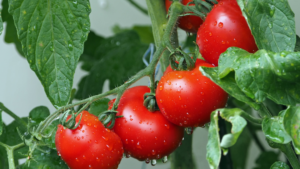
By the end of April, you can plant your tomato seedlings into the greenhouse. It’s still a good deal too early for outdoors but in the protected atmosphere of a greenhouse – and if there’s no forecast of severe frosts – planting them in the greenhouse is okay.
#9 Plant strawberries
Another garden task in April is planting new strawberries and protecting them with a fleece. If you have strawberries in your garden already, remove all wilted leaves now. They may be infected with diseases and, by removing them, you can prevent those from spreading.
#10 Pollinators
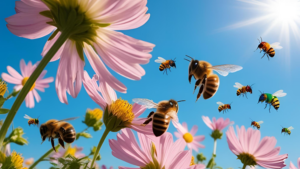
All fruit-bearing vegetables, as well as fruit trees and bushes, need pollinators to produce their fruits. We can help attract all those bees and insects by sowing flower strips as insect pastures, either on the borders of our vegetable garden or in the patches between the plants. Calendula, for example, is not only a great attractor for pollinating insects but can be used for teas as well as an ingredient in many homemade body care products.
The gardening season has started! Let’s get out and green the world.
Can’t get enough? These articles may also interest you:
How to start a vegetable garden
Crop rotation in vegetable gardening
Calendula Soap (Beginner’s recipe)
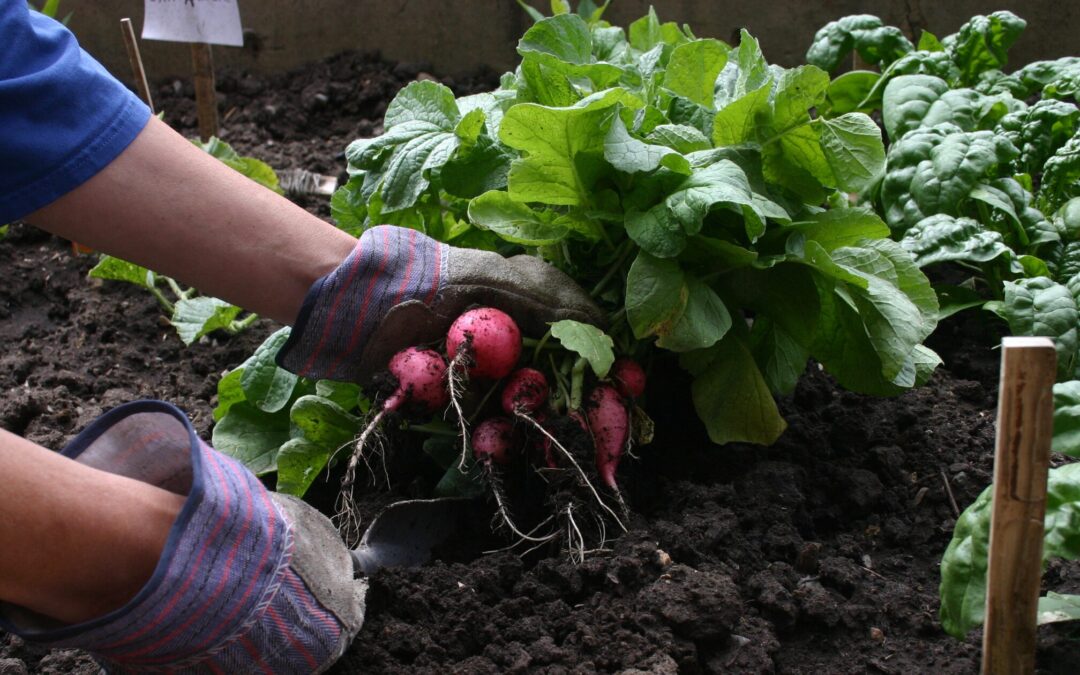
by Angela Braun | Apr 3, 2025 | Gardening
April marks the exciting transition when your vegetable garden truly comes to life. As soil temperatures rise and the threat of frost begins to fade in many regions, this month offers the perfect opportunity to get your hands dirty and lay the foundation for a great harvest.
With longer days and warming temperatures, April is prime time for both direct sowing and transplanting a wide variety of vegetables. Whether you’re a seasoned gardener or trying your hand at growing food for the first time, this month’s activities will set the stage for months of fresh, homegrown produce.
Let’s explore what vegetables you can sow and plant in April in your garden and how to give them the best start for a successful growing season.
Seed-starting indoors
If you’re new to seed-starting, you may want to read up and learn about all the necessary steps and equipment. Let’s have a look at what can be sown indoors in April:
Leek
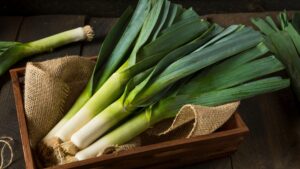
Sow winter leek indoors now. I either sow 2 – 3 seeds per small pot, or I take a larger container and sow them in rows that I will be thinning later.
Brassicas
Although we can plant the first batch of brassicas like broccoli, kohlrabi, cauliflower, white and red cabbage outdoors now, we should still sow a second batch indoors. That way, we can transplant them outdoors several weeks from now and have a continuous harvest of brassicas instead of one overwhelming flood of harvest.
Seeing that those second batches will be outside in summer, we may have to choose late instead of early varieties.
Lettuce
Like with cabbage, the second round of lettuce-starting has begun! Now, however, we want to choose varieties that like warmer weather, like, for example, iceberg and oak leaf lettuce.
Tomatoes
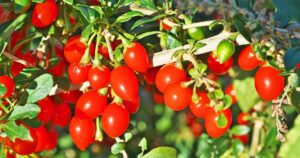
If you haven’t seed-started tomatoes for outdoor planting already, mid-April is the latest time to do so. Sow several seeds per pot and thin them later.
Cucurbitaceae

The family of Cucurbitaceae consists of cucumbers, zucchini, melons and pumpkins, and they can all be seed-started indoors in April. None of them, however, takes thinning very well and
Vegetables we can sow outdoors in April
Broad beans
The beginning of April is the latest time to sow broad beans. They are very tolerant of low temperatures and can even withstand light frosts, which is why they don’t need protection against the cold.
Peas / Sugar peas
There are early varieties that can be sown outdoors mid to end of March. Just remember that peas are climbers and therefore install a trellis or net between the rows.
Carrots
Again, we’re talking early varieties here. If you planted onion bulbs in autumn, sow the carrots in the rows between the onions. That way, carrots and onions will protect one another from harmful pests.
Radishes
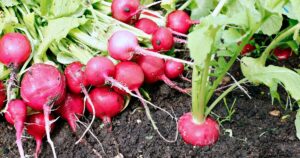
Carrots need quite some time to germinate, and it’s difficult, therefore, to weed the rows. A trick to still see where the carrots have been sown is to mix radish seeds between the carrot seeds. Radishes need only a few days to germinate and then not only show us the row but are a yummy vegetable for salads or as a ferment.
Lettuce
Contrary to the varieties we start indoors now, lettuce we sow outdoors in April has to be very tolerant against cold temperatures, like Asia lettuce. If we mix the early varieties we sow now and the later varieties we seed-start indoors, we can continually harvest different kinds of leafy greens. This method of sowing vegetables every 3 – 4 weeks is called succession planting which not only ensures a continuous harvest but also that the soil in our patches is always covered.
All lettuce varieties germinate in light only. Do not cover them with soil!
Rocket salad
is an easy one! Sow it, harvest he leaves, and when you let it bloom, it will spread itself.
Spinach
Spinach is almost a no-brainer: sow it, cover it with winter protection fleece and just let it grow. It’s usually quite tolerant of the cold and will grow well under protective cover.
Beetroot
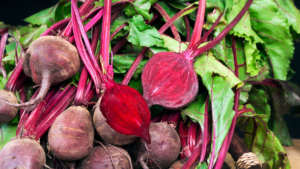
Although you can seed-start beetroot indoors, that’s only advisable when you have a small garden or want to grow just some of them. In our family, we need plenty of beetroot for salads, pickles, fermented or cooked, and that’s why I sow them directly in April.
Salsify
Salsifies need a deep, loose soil to grow long, straight roots. A patch where potatoes grew the year before would therefore be ideal.
Planting outdoors
Before we plant anything outdoors, it’s important to harden the seedlings off by gradually exposing them to outdoor temperatures. Start by putting your plants outside or in the greenhouse for 2 – 3 hours at first and prolong that time over a week before transplanting.
Lettuce
The lettuce that we started in February or March is now ready for transplanting outside. Make sure that the seedlings are not planted too deeply, or they may rot. As a rule of thumb, put them into the soil as deep as they were in the pot.
Brassicas
All early brassica seedlings like kohlrabi, early Savoy cabbage and cauliflower as well as white and red cabbage, can be planted outdoors in April. Leave plenty of space between the seedlings so that you can plant celery in between later. Cabbage and celery are great companions in the patch and repel each other’s pests.
Leek
Plant leeks between the cabbage rows. That way, you not only make the best use of space here, seeing that cabbage grows on the ground and leek on the “first floor”, but they also deter pests from one another. For best protection, however, cover them with a pest protection net.
Garlic
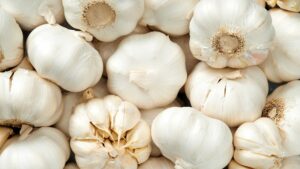
I usually plant garlic bulbs in autumn, but you can still do so now. Hop over here to get a detailed guide on how to best plant garlic.
Onions / Shallots
Like garlic, onions and shallots can be planted now. Either plant small bulbs you can buy at the nursery or the seedlings you’ve started indoors earlier that year.
Potatoes
In my hardiness zone 7b, I don’t plant potatoes before the end of April. Considering that our last night frosts can happen until mid-May, the end of April is perfect for putting the pre-sprouted potatoes in the ground. When the shoots start looking out of the soil, the worst weather will be over.
The gardening season has officially started! Time to dig in the dirt!
Not enough garden talk? You may like these articles:
What to Sow and Plant in April: Kickstarting Your Vegetable Garden
Easy Vegetables for Beginners: 11 Foolproof Crops for Your First Garden in 2025
23 Common Vegetable Gardening Mistakes (And How to Fix Them!)































